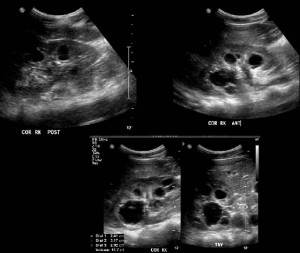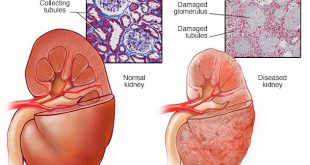Introduction and definition
Renal cysts results from genetic or non-genetic processes. Renal cysts are round pouches of fluid that can form within the kidneys or on the kidneys. The most common causes of renal cysts in adults are :
- simple renal cysts
- autosomal dominant polycystic kidney disease (PKD); and
- acquired cystic disease in patients with end-stage renal disease (ESRD) after several years of dialysis.
The other uncommon causes of cystic kidney diseases include :
- medullary sponge kidney
- autosomal recessive polycystic kidney disease (PKD)
- autosomal dominant interstitial kidney disease (previously called medullary cystic kidney
disease). - von Hippel-Lindau disease
- tuberous sclerosis complex
- nephronophthisis.
Renal cysts are categorized as simple or complex. The Bosniak renal cyst classification system was created to help distinguish simple renal cysts from complex renal cysts.
Symptoms
Simple renal cysts typically do not cause any signs of symptoms. Larger renal cysts may cause abdominal pain or fever if the cysts get infected.
Diagnosis
Simple renal cysts may be diagnosed incidentally on routine ultrasonography examination. If the ultrasonogram study is equivocal or there is presence of calcifications or septae in the renal cysts, a computed tomography scan should be considered to further assess the characteristics of the renal cyst.
Complications
Some simple renal cysts have rarely been associated with rupture, haematuria, abdominal pain, abdominal swelling, infection and/or hypertension.
Below, we will discuss about some of the more relevant cystic kidney disease:
Autosomal Dominant Polycystic kidney disease (ADPKD)
ADPKD is a systemic disease that can be hereditary. It is characterised by multiple renal cysts in both kidneys. The cyst can rupture causing pain, haematuria and/or infection. Cysts haemorrhages are best managed conservatively and any evidence of infection should be treated with antibiotics. A significant proportion of adult ADPKD patients have hypertension.
Tuberous sclerosis
Tuberous sclerosis (TS) is characterised by multiple benign congenital tumours occurring in the brain, retina, skin, heart, kidneys, liver, lungs and/or bone. Patients with tuberous sclerosis may develop multiple and bilateral angiomyolipoma in the kidneys, with or without cysts.
Von-Hippel-Lindau disease (VHL)
Von-Hippel-Lindau is a rare form of inheritable disease. Patients with Von-Hippel-Lindau disease may develop benign or malignant tumours such as hemangioblastomas (including retinal hemangioblastomas), clear cell renal cell carcinomas (RCCs), pheochromocytomas, endolymphatic sac tumors (ELSTs) of the middle ear, serous cystadenomas and neuroendocrine tumors of the pancreas, and papillary cystadenomas of the epididymis and broad ligament.
Acquired cystic renal disease
In patients with chronic kidney disease, cyst formation may start before dialysis initiation. Renal cysts may be seen in up to 80% of patients on dialysis for over 10 years. 1 Patients with acquired cystic kidney disease may be asymptomatic. However, the cysts may increase in size which can then cause bleeding, retroperitoneal haematoma, abdominal pain, haematuria and/or urinary tract infection. In some cases, the cysts may become malignant. The prevalence of renal cell carcinoma in long-term dialysis patients is reported to be 1%. 2
In patients who have been on dialysis for three or more years without a limited life expectancy, initial screening with ultrasonography is suggested. A contrast-enhanced study may be required to assess further the characteristics of complex cysts.
References
- Matson MA, Cohen EP. Acquired cystic kidney disease: occurrence, prevalence and renal cancers. Medicine 1990; 69:217.
- Marple JT, MacDougall M, Chonko AM. Renal cancer complicating acquired cystic kidney disease. J. Am. Soc. Nephrol. 1994; 4:1951-1956.
- www.uptodate.com
- Schrier RW. Diseases of the kidney and urinary tract. Eighth Edition. 2007


| Last Reviewed | : | 3 June 2016 |
| Writer | : | Dr. Esther Tan Zhao Zhi |
| Accreditor | : | Dr. Liu Wen Jiun |
 PENDIDIKAN PESAKIT Kementerian Kesihatan Malaysia
PENDIDIKAN PESAKIT Kementerian Kesihatan Malaysia
